Caryn
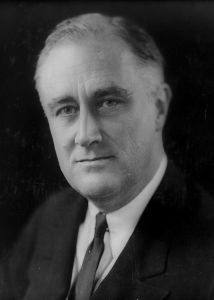
 As a part of fallout of the Great Depression, and as a product of the “New Deal” ambitions of Franklin D Roosevelt, America came into the new era of Social Security, a plan to assign unique nine-digit numbers to some 26 million US workers. The plan didn’t exactly do what it was supposed to do, in a number of ways, and it has as to “social security,” it has been anything but. Social Security was not intended to be a national ID number, but it has turned out to be exactly that. It has been used by banks and insurance agencies, to track tax returns, and to identify college students. By the 1970s, Social Security numbers indexed a wealth of sensitive information in computer data banks, becoming a severe risk for identity theft, and prompting major privacy legislation. These types of security issues could not have been anticipated by the pre-computer, pre-internet, and pre-hacking America of the 1930s, when Social Security was founded.
As a part of fallout of the Great Depression, and as a product of the “New Deal” ambitions of Franklin D Roosevelt, America came into the new era of Social Security, a plan to assign unique nine-digit numbers to some 26 million US workers. The plan didn’t exactly do what it was supposed to do, in a number of ways, and it has as to “social security,” it has been anything but. Social Security was not intended to be a national ID number, but it has turned out to be exactly that. It has been used by banks and insurance agencies, to track tax returns, and to identify college students. By the 1970s, Social Security numbers indexed a wealth of sensitive information in computer data banks, becoming a severe risk for identity theft, and prompting major privacy legislation. These types of security issues could not have been anticipated by the pre-computer, pre-internet, and pre-hacking America of the 1930s, when Social Security was founded.
In November of 1936, the newly formed Social Security Board set out to assign those unique nine-digit numbers American workers. They called this a task “of a magnitude never before equaled in any Government or private undertaking.” The first Social Security number was issued on December 1, 1936, to a man named John David Sweeney Jr. Sweeney, a 23-year-old man was noted as saying that his retirement was “a long way off.” Since that time Social Security has suffered many types of abuse, and a gross miscalculation in funds, mainly stemming from the fact that with the legalizing of abortion, millions of Americans who would have eventually earned wages and paid into the program, were murdered, bringing a shortage of funds in unprecedented proportions. People will surely argue one or more of the points made here, but the facts remain.
A product of its time, the Social Security Number came about due to the economic wreckage of the Great Depression and the disastrous New Deal ambitions of Franklin D Roosevelt. People didn’t really understand the ramifications of the Social Security Numbers, because the program was overshadowed by the nation-changing program of which they were part. Nevertheless, those numbers would become affixed to nearly every American life over the next century, while spurring new uses of punch cards and filing systems, as well as all the new dilemmas around data and security. In the end, it would probably been better if we had never started it, but then I suppose that some type of national identification system was inevitable. We are a very large nation, and 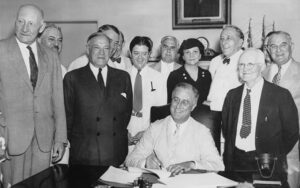
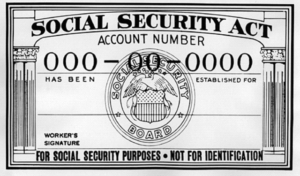 in my opinion, IDs should be used for many things, such as voting, flying, re-entry to our borders, and a host of other things that make each of us unique. Maybe Social Security numbers were the only way, or maybe we could have waited on this program until we could have found a more “secure” form of Social Security.
in my opinion, IDs should be used for many things, such as voting, flying, re-entry to our borders, and a host of other things that make each of us unique. Maybe Social Security numbers were the only way, or maybe we could have waited on this program until we could have found a more “secure” form of Social Security.
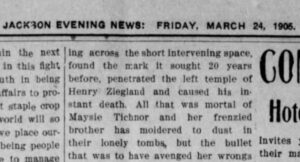 I think every one of us has been the victim of a hoax. Hoaxes are like a joke…a bad joke. In reality, a hoax is a cruel scheme designed to pull one over on their intended victim. One such hoax was the story of “The Patient Bullet.” As the story goes, a man named Henry Ziegland dumped his fiancé, Maysie Tichnor, in 1883 in the town of Honey Grove, Texas. So upset was Tichnor, that she actually committed suicide. Her brother was distraught and enraged, so he decided that Ziegland had to die in retaliation. He immediately went to Ziegland’s farm and shot the young man who had hurt his sister, then so as not to face prison, he turned the gun on himself.
I think every one of us has been the victim of a hoax. Hoaxes are like a joke…a bad joke. In reality, a hoax is a cruel scheme designed to pull one over on their intended victim. One such hoax was the story of “The Patient Bullet.” As the story goes, a man named Henry Ziegland dumped his fiancé, Maysie Tichnor, in 1883 in the town of Honey Grove, Texas. So upset was Tichnor, that she actually committed suicide. Her brother was distraught and enraged, so he decided that Ziegland had to die in retaliation. He immediately went to Ziegland’s farm and shot the young man who had hurt his sister, then so as not to face prison, he turned the gun on himself.
The brother died by suicide, but Ziegland did not die. In fact, somehow, he had even escaped serious injury. The bullet had only grazed him before hitting a tree. In what seemed a gross miscarriage of justice, Ziegland went on to live a prosperous life and had a family. Then, twenty years after he literally dodged a bullet, Ziegland and his son were cutting firewood. It so happened that they cut down the tree with the bullet in it. The wood in that tree was so tough that it was almost impossible to split it with an 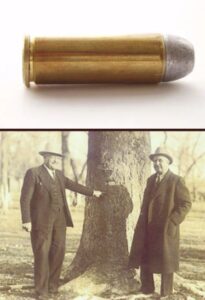 axe. Ziegland decided to bore some holes in the fallen tree and put small amounts of dynamite in the holes. After moving about 50 feet away, Ziegland and his son set the explosions off. Shockingly, the bullet, which had waited twenty years for Henry Ziegland, was blown out of the tree with great force and the farmer was hit in the left temple and killed instantly…so the story goes anyway.
axe. Ziegland decided to bore some holes in the fallen tree and put small amounts of dynamite in the holes. After moving about 50 feet away, Ziegland and his son set the explosions off. Shockingly, the bullet, which had waited twenty years for Henry Ziegland, was blown out of the tree with great force and the farmer was hit in the left temple and killed instantly…so the story goes anyway.
Some hoaxes are pretty easy to figure out, but others, like the Ziegland story, sort of seemed plausible. Because of that, The Patient Bullet story was fairly popular. It was posted all over the Internet, complete with a picture of the bullet and the tree. The story appeared over 100 times in the newspapers, where it was presented as legitimate news. Nevertheless, there is quite a bit of evidence to suggest the story of Henry Ziegland was a hoax. In reality, there is no record of anyone with the names Ziegland or Tichnor or anything similar that ever lived in Honey Grove. In fact, a thorough search shows no vital records for people who match these dates and descriptions in Texas or any other state, for that matter.
The story was first appeared in the Jackson Mississippi Evening News in March 24, 1905. The tale was interesting, and it took off like wildfire. It was picked up by several papers, and began, “A marvelous case of punishment on earth for the sins of the flesh occurred in Dryno township, in this county, today. Twenty years ago Henry Ziegland, then a handsome, wealthy young man, jilted beautiful Maysie Tichnor, and the girl committed suicide…” After that the story disappeared for the better part of the decade, before it inexplicably 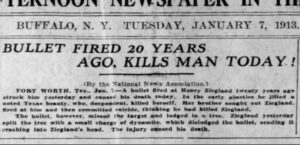 reappeared in 1913. The names were the same, but the newspapers still ran the story as current news. This time, the story’s fame grew. It ran in newspapers from Edmonton (Canada) to New Orleans to Buffalo. It’s almost a comical situation, because it was probably started by a couple of teenagers sitting around in 1905, who came up with this funny little story and decided to see if they could trick a newspaper into publishing it. Well, not only were they able to get it published, but by 1913, it was appearing in international newspapers. Now, over a century later, the story is still viewed as truth. In fact, a Google search for “Henry Ziegland bullet” produces over 5,400 results!
reappeared in 1913. The names were the same, but the newspapers still ran the story as current news. This time, the story’s fame grew. It ran in newspapers from Edmonton (Canada) to New Orleans to Buffalo. It’s almost a comical situation, because it was probably started by a couple of teenagers sitting around in 1905, who came up with this funny little story and decided to see if they could trick a newspaper into publishing it. Well, not only were they able to get it published, but by 1913, it was appearing in international newspapers. Now, over a century later, the story is still viewed as truth. In fact, a Google search for “Henry Ziegland bullet” produces over 5,400 results!
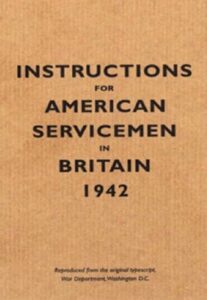
 In every branch of service, and every war, the US servicemen are given a handbook. The book is filled with useful information, meant to make the transition from civilian to soldier a successful one, even if it is not an easy one. No young civilian preparing to go to war really has a good idea of what they are getting into. I suppose more of them do these days, than their World War and prior wars era counterparts. Nevertheless, each of them is proceeding head on into a massive reality check. The handbook can be a sobering little book, especially when the new soldier reads the chapter that recommends the writing of a will. The need for a Last Will and Testament will become crystal clear when the soldier sees his (or her) first battle. The sight of dead bodies takes away any misconception the soldier might have of their own mortality, and the possibility that they may have been given a one-way ticket to this battle.
In every branch of service, and every war, the US servicemen are given a handbook. The book is filled with useful information, meant to make the transition from civilian to soldier a successful one, even if it is not an easy one. No young civilian preparing to go to war really has a good idea of what they are getting into. I suppose more of them do these days, than their World War and prior wars era counterparts. Nevertheless, each of them is proceeding head on into a massive reality check. The handbook can be a sobering little book, especially when the new soldier reads the chapter that recommends the writing of a will. The need for a Last Will and Testament will become crystal clear when the soldier sees his (or her) first battle. The sight of dead bodies takes away any misconception the soldier might have of their own mortality, and the possibility that they may have been given a one-way ticket to this battle.
While many of the things contained in the handbook are sobering and even quite scary for the soldiers, there are some things contained therein that have a much more practical usage, and a few that looking back, anyway, are just a little bit funny. One such tidbit contained in the US servicemen’s World War II handbook was the simple statement that, “The British don’t know how to make a good cup of coffee. You don’t know how to make a good cup of tea—it’s an even swap.” I suppose that statement is true, at least as it pertains to the fact that British “bad coffee” is an even swap with US “bad tea.” I don’t think they US government was trying to “bad-mouth” the Brits, but rather that they were simply stating a fact. If the men were in a British camp, they simply shouldn’t ask for a cup of coffee, because they would be sorely disappointed in what they were served.
Like the warning labels of items these days, like not to shower with a running blow dryer, or to shut off the engine before trying to remove the fan belt on your car, the point was to make the reader aware of the ramifications of making such bad choices. Still, some “warnings” make more sense than others…or do they? While the electricity problem of the wet running blow dryer and the finger removal outcome of putting one’s 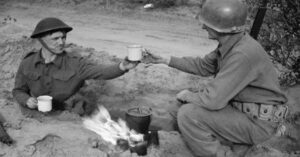 hand out to touch a fast-moving fan belt, seem like rather stupid wisdom (is there is such a phrase), the idea that a person would automatically make a bad cup of coffee, simply because they are British, seems equally ridiculous. Nevertheless, the US servicemen were warned to expect “bad coffee” from the British, so that they were prepared to either drink tea with the Brits, or swallow down the offending coffee so as not to offend the Brits. I’m sure that much of the rest of the handbook contained valuable information, but it is possible that the most valuable information contained in the World War II US servicemen’s handbook, was intended to avoid the notion that the Brit might have poisoned them with the British coffee.
hand out to touch a fast-moving fan belt, seem like rather stupid wisdom (is there is such a phrase), the idea that a person would automatically make a bad cup of coffee, simply because they are British, seems equally ridiculous. Nevertheless, the US servicemen were warned to expect “bad coffee” from the British, so that they were prepared to either drink tea with the Brits, or swallow down the offending coffee so as not to offend the Brits. I’m sure that much of the rest of the handbook contained valuable information, but it is possible that the most valuable information contained in the World War II US servicemen’s handbook, was intended to avoid the notion that the Brit might have poisoned them with the British coffee.
 After informing his chief advisors and cabinet on July 22, 1862, that he would issue a proclamation to free enslaved people, President Abraham Lincoln added that he will wait until the Union Army has achieved a substantial military victory to make the announcement. One might wonder why the president would wait to make the announcement. It seems strange, but the reality is that he was attempting to stitch back together a nation that was being torn apart in a bloody civil war. His decision was a last-ditch, but carefully calculated, executive decision regarding the institution of slavery in America. Slavery was at the heart of the war, but at the time of the meeting with his cabinet, things were not looking good for the Union. to lose the war outright, could put an end to any possibility of freedom and of unity in this nation. The Confederate Army had overcome Union troops in significant battles, and to make matters worse, Britain and France were set to officially recognize the Confederacy as a separate nation. Lincoln was doing everything he could to see to it that that never happened.
After informing his chief advisors and cabinet on July 22, 1862, that he would issue a proclamation to free enslaved people, President Abraham Lincoln added that he will wait until the Union Army has achieved a substantial military victory to make the announcement. One might wonder why the president would wait to make the announcement. It seems strange, but the reality is that he was attempting to stitch back together a nation that was being torn apart in a bloody civil war. His decision was a last-ditch, but carefully calculated, executive decision regarding the institution of slavery in America. Slavery was at the heart of the war, but at the time of the meeting with his cabinet, things were not looking good for the Union. to lose the war outright, could put an end to any possibility of freedom and of unity in this nation. The Confederate Army had overcome Union troops in significant battles, and to make matters worse, Britain and France were set to officially recognize the Confederacy as a separate nation. Lincoln was doing everything he could to see to it that that never happened.
Lincoln’s plan was to issue the Emancipation Proclamation, which strangely, had less to do with ending slavery 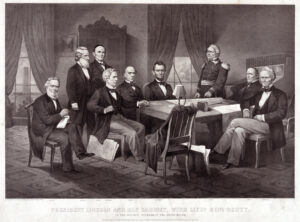 than saving the crumbling union. In an August 1862 letter to New York Tribune editor Horace Greeley, Lincoln confessed that, “My paramount object in this struggle is to save the Union, and it is not either to save or to destroy slavery.” I never knew that, somehow. Lincoln was highly patriotic, and his objective was that of hoping that a strong statement declaring a national policy of emancipation would stimulate a rush of the South’s enslaved people into the ranks of the Union Army. He hoped that such a rush of manpower would resupply the Union forces, while depleting the Confederacy’s labor force, on which it depended to wage war against the North. Lincoln was against slavery, but he was for America more. That seems like a strange compromise, but I assume he thought freeing the slaves was a fight for another day. That decision would eventually get him killed.
than saving the crumbling union. In an August 1862 letter to New York Tribune editor Horace Greeley, Lincoln confessed that, “My paramount object in this struggle is to save the Union, and it is not either to save or to destroy slavery.” I never knew that, somehow. Lincoln was highly patriotic, and his objective was that of hoping that a strong statement declaring a national policy of emancipation would stimulate a rush of the South’s enslaved people into the ranks of the Union Army. He hoped that such a rush of manpower would resupply the Union forces, while depleting the Confederacy’s labor force, on which it depended to wage war against the North. Lincoln was against slavery, but he was for America more. That seems like a strange compromise, but I assume he thought freeing the slaves was a fight for another day. That decision would eventually get him killed.
Lincoln waited to unveil the proclamation until he could do so on the heels of a successful Union military  advance, just as he had promised. After a victory at Antietam, Lincoln publicly announced a preliminary Emancipation Proclamation on September 22, 1862, declaring all enslaved people free in the rebellious states as of January 1, 1863. Lincoln and his advisors limited the proclamation’s language to slavery in states outside of federal control as of 1862, which might seem odd, but if the war was lost by the Union, it wouldn’t have mattered anyway, and he needed the support of the North. Not all of the people in the north were in total agreement with the freeing of the slaves, although the vast majority were. The proclamation did not address the contentious issue of slavery within the nation’s border states. In his attempt to appease all parties, Lincoln left many loopholes open that civil rights advocates would be forced to tackle in the future. I have learned, in reference to politics, that many a politician has been forced to practice a little “appeasing” in order to get anything accomplished. I can’t say that is a good thing, but rather that it is sometimes a necessary thing.
advance, just as he had promised. After a victory at Antietam, Lincoln publicly announced a preliminary Emancipation Proclamation on September 22, 1862, declaring all enslaved people free in the rebellious states as of January 1, 1863. Lincoln and his advisors limited the proclamation’s language to slavery in states outside of federal control as of 1862, which might seem odd, but if the war was lost by the Union, it wouldn’t have mattered anyway, and he needed the support of the North. Not all of the people in the north were in total agreement with the freeing of the slaves, although the vast majority were. The proclamation did not address the contentious issue of slavery within the nation’s border states. In his attempt to appease all parties, Lincoln left many loopholes open that civil rights advocates would be forced to tackle in the future. I have learned, in reference to politics, that many a politician has been forced to practice a little “appeasing” in order to get anything accomplished. I can’t say that is a good thing, but rather that it is sometimes a necessary thing.

 The Hippopotamus is a large, lumbering animal found mostly in Africa, or in zoos in other places. These animals are rather hot blooded and since Africa is often hot too, the like to spend much of their day almost totally immersed in water in an effort to stay cool. The hippopotamus has a bulky body with stumpy legs, an enormous head with a mouth to match, a short tail, and four toes on each foot. Each of the toes has a nail-like hoof. Male hippos are usually about 11.5 feet long, stand 5 feet tall, and weigh 3.5 tons…yes that’s tons…strange considering their relatively short stature. The males are the larger gender in terms of physical size, weighing about 30 percent more than females. The nearly hairless skin is 2 inches thick on the flanks, but thinner elsewhere. Hippos are grayish brown in color, with pinkish underparts. Their huge mouth is half a meter wide and can gape 150° to show the teeth. When the mouth is open, the head almost completely disappears. The lower teeth are very sharp and can be more than 12 inches long.
The Hippopotamus is a large, lumbering animal found mostly in Africa, or in zoos in other places. These animals are rather hot blooded and since Africa is often hot too, the like to spend much of their day almost totally immersed in water in an effort to stay cool. The hippopotamus has a bulky body with stumpy legs, an enormous head with a mouth to match, a short tail, and four toes on each foot. Each of the toes has a nail-like hoof. Male hippos are usually about 11.5 feet long, stand 5 feet tall, and weigh 3.5 tons…yes that’s tons…strange considering their relatively short stature. The males are the larger gender in terms of physical size, weighing about 30 percent more than females. The nearly hairless skin is 2 inches thick on the flanks, but thinner elsewhere. Hippos are grayish brown in color, with pinkish underparts. Their huge mouth is half a meter wide and can gape 150° to show the teeth. When the mouth is open, the head almost completely disappears. The lower teeth are very sharp and can be more than 12 inches long.
Hippopotamus is Greek for “river horse” mainly because of their love of water. So much do they love the water, that Hippos spend up to 16 hours a day submerged in rivers and lakes to keep their massive bodies cool under the hot African sun. As clumsy as they might seem on land, hippos are graceful in water, good swimmers, and can hold their breath underwater for up to five minutes. Often, in the shallow lakes, hippos are large enough to simply walk or stand on the lake floor or lie in the shallows. Because their eyes and nostrils are located high on their heads, they have the ability to see and breathe while mostly submerged. While they spend a lot of time in the water, hippos also like to enjoy the sun on the shoreline and strangely, their bodies secrete an oily red substance, which is where the myth that they sweat blood came from. The liquid is actually a skin moistener and sunblock that may also provide protection against germs. What most people wouldn’t give to have built in moisturizer and sunblock…well, maybe not a heavy sunblock. Hippos come out of the water at sunset and begin their nightly feeding cycle. Often traveling up to six miles, they consume up to 80 pounds of grass. Now, that’s a lot of carbs, but given their size, that is not that much food. Hippos seem like a slow animal, but if they are threatened on land hippos may run for the water, and they can match a human’s speed…for short distances.
In the past, hippos have been used to pull a cart, much like a horse. I suppose it was a common site in Africa, 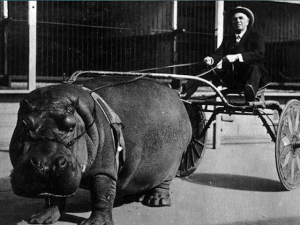
 but for most of us today, it would be a strange sight indeed. There was a hippo in the Barnes Circus, names Lotus. Lotus was an obedient cart hippo, but I’m not so sure she was very happy about that cart that was hooked on behind her. It makes sense that she would be unhappy, she was in captivity, and that she couldn’t have been happy with her life. I wonder what would happen if Lotus had been spooked near a pond. My guess is that there would have been one wet driver.
but for most of us today, it would be a strange sight indeed. There was a hippo in the Barnes Circus, names Lotus. Lotus was an obedient cart hippo, but I’m not so sure she was very happy about that cart that was hooked on behind her. It makes sense that she would be unhappy, she was in captivity, and that she couldn’t have been happy with her life. I wonder what would happen if Lotus had been spooked near a pond. My guess is that there would have been one wet driver.

 My grandnephew, Dylan Herr is one busy guy. Dylan is the owner/manager of Red Wing Shoes in Casper, Wyoming, but now he is also managing all of his family’s Red Wing stores. Because of his new position, Dylan has been traveling to and from Colorado quite often, checking in on the stores and training new hires. Right now, Dylan is in Red Wing Minnesota, with some other managers, looking at all the original Red Wing stuff there. Dylan is really enjoying this trip. In addition to all of his new duties, Dylan is also still working at his store in Casper of course. I know that Dylan’s family really appreciates all his hard work. They are a close family, and family helps family. And Dylan is the man for the job.
My grandnephew, Dylan Herr is one busy guy. Dylan is the owner/manager of Red Wing Shoes in Casper, Wyoming, but now he is also managing all of his family’s Red Wing stores. Because of his new position, Dylan has been traveling to and from Colorado quite often, checking in on the stores and training new hires. Right now, Dylan is in Red Wing Minnesota, with some other managers, looking at all the original Red Wing stuff there. Dylan is really enjoying this trip. In addition to all of his new duties, Dylan is also still working at his store in Casper of course. I know that Dylan’s family really appreciates all his hard work. They are a close family, and family helps family. And Dylan is the man for the job.
The hardest part about all the travel that Dylan is doing right now is being away from his family. Dylan is, first and foremost, a family man. His wife, Katy and son, Max are 
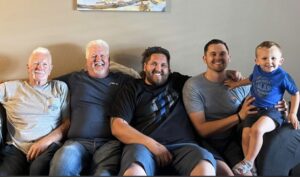 his top priority. All that travel makes spending quality time with family hard, so sometimes Katy and Max “tag along” with Dylan when he travels. That is really nice, and in addition, Dylan makes sure that on his days off, he makes sure to spend his time with Max!! A boy needs time with his daddy, and Dylan is a great daddy.
his top priority. All that travel makes spending quality time with family hard, so sometimes Katy and Max “tag along” with Dylan when he travels. That is really nice, and in addition, Dylan makes sure that on his days off, he makes sure to spend his time with Max!! A boy needs time with his daddy, and Dylan is a great daddy.
Dylan also makes sure to take care of things around the house when he is home. That means doing yard work. Dylan loves his yard. In fact, according to Katy, he is “obsessed” with having a flawless lawn, and never really thinks it’s quite perfect 
 enough. Now if all this isn’t enough, Dylan also spends time going to the gym and playing on a softball team (when he is in town). He has also played in a lot of golf tournaments this summer as well, which is definitely his passion…after his stores, Katy, and Max, of course. Dylan is very dedicated to community. This year, he joined the board of the YMCA and is also part of the Casper Rotary, which he absolutely loves. For Katy, Dylan’s schedule is a extremely overwhelming. She told me that some days, she can’t even keep track of where he’s on a day-to-day basis. Of course, Dylan talks to her every day, but I can certainly see how such a hectic schedule would be hard to keep up with. Today is Dylan’s birthday. Happy birthday Dylan!! Have a great day…wherever you are!! We love you!!
enough. Now if all this isn’t enough, Dylan also spends time going to the gym and playing on a softball team (when he is in town). He has also played in a lot of golf tournaments this summer as well, which is definitely his passion…after his stores, Katy, and Max, of course. Dylan is very dedicated to community. This year, he joined the board of the YMCA and is also part of the Casper Rotary, which he absolutely loves. For Katy, Dylan’s schedule is a extremely overwhelming. She told me that some days, she can’t even keep track of where he’s on a day-to-day basis. Of course, Dylan talks to her every day, but I can certainly see how such a hectic schedule would be hard to keep up with. Today is Dylan’s birthday. Happy birthday Dylan!! Have a great day…wherever you are!! We love you!!
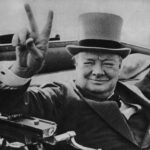 Many people today think of the “V” sign as meaning Peace, but in reality, the “V” sign used today was actually hijacked. The original “V” sign meant Victory, and it was originally presented as such by Winston Spencer-Churchill at a time when Britain is at one of its lowest points in World War II. Churchill is well known as one of the greatest motivators and speech makers of his time. On July 19, 1941, he launched the “V for Victory” campaign across Europe by telling those in Europe under Nazi control to use the letter “V” (for Victory) at every chance they got in speaking and writing. Churchill urged them to write a capital letter “V” to signify “V” for Victory. This was designed to let the Germans know they still had spirit and believed they would overcome Nazi Rule. The morale of the people was so important and this low point in history. When people give up hope, wars are lost…even before the battles are lost.
Many people today think of the “V” sign as meaning Peace, but in reality, the “V” sign used today was actually hijacked. The original “V” sign meant Victory, and it was originally presented as such by Winston Spencer-Churchill at a time when Britain is at one of its lowest points in World War II. Churchill is well known as one of the greatest motivators and speech makers of his time. On July 19, 1941, he launched the “V for Victory” campaign across Europe by telling those in Europe under Nazi control to use the letter “V” (for Victory) at every chance they got in speaking and writing. Churchill urged them to write a capital letter “V” to signify “V” for Victory. This was designed to let the Germans know they still had spirit and believed they would overcome Nazi Rule. The morale of the people was so important and this low point in history. When people give up hope, wars are lost…even before the battles are lost.
In this campaign, Churchill first gave a speech over the radio to tell the people of his plan. Immediately following his speech, the letter “V” began to appear everywhere. It was painted on walls, tapped out in Morse code on shop counters with knuckles or beer glasses or pencil stubs. It quickly became a rallying call across Europe that there was still hope. Many people weren’t aware, but this is also why Churchill’s most famous pictures from World War II always featured him giving the “V” for Victory Sign. He was continuously telling the people not to give up. That all was not lost, and Victory would still be theirs. We all know the “V” sign. Of course, it was made using the index and middle fingers, raised and parted to make a “V” shape while the other fingers are clenched.
These days, it can mean a number of things, and not all are good. When it is displayed with the palm inward 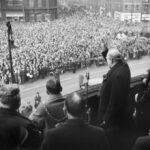 toward the signer, it can be an offensive gesture in some Commonwealth nations (similar to showing the middle finger). That usage dates back to at least 1900. When it is given with the palm outward, it is to be read as a victory sign (“V for Victory”). This usage was first introduced in January 1941 as part of a campaign by the Allies of World War II and made more widely known by Churchill the following July. As most of us know, during the Vietnam War, in the 1960s, the “V sign” with palm outward was widely adopted by the counterculture as a symbol of peace. These days, that is the most commonly used meaning and is commonly called the “peace sign.” Of course, most of us also know that it is used for fun in photographs, especially in East Asia and the United States, where the gesture is also associated with cuteness…the “rabbit ears.” That one is one I have never really figured out. Not what it is, but why people think it’s so funny. Oh well…to each his own.
toward the signer, it can be an offensive gesture in some Commonwealth nations (similar to showing the middle finger). That usage dates back to at least 1900. When it is given with the palm outward, it is to be read as a victory sign (“V for Victory”). This usage was first introduced in January 1941 as part of a campaign by the Allies of World War II and made more widely known by Churchill the following July. As most of us know, during the Vietnam War, in the 1960s, the “V sign” with palm outward was widely adopted by the counterculture as a symbol of peace. These days, that is the most commonly used meaning and is commonly called the “peace sign.” Of course, most of us also know that it is used for fun in photographs, especially in East Asia and the United States, where the gesture is also associated with cuteness…the “rabbit ears.” That one is one I have never really figured out. Not what it is, but why people think it’s so funny. Oh well…to each his own.
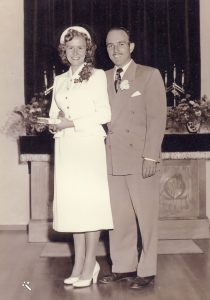
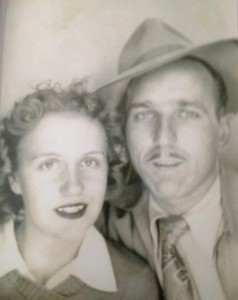 It’s so hard to believe that my parents Allen and Collene Spencer, got married 70 years ago today. When they got married, our mom was a young girl of 17½, with stars in her eyes. Dad was 29, which was not so uncommon back then…after all, her parents were 16 years apart. Their ages, young or older, didn’t matter, because their love was real and forever. And they never seemed like they were 12 years apart in age. They became a family of three ten months later, and over the next nine years they became a family of seven, with five daughters to their credit. While we weren’t rich in money, our family was so rich in love.
It’s so hard to believe that my parents Allen and Collene Spencer, got married 70 years ago today. When they got married, our mom was a young girl of 17½, with stars in her eyes. Dad was 29, which was not so uncommon back then…after all, her parents were 16 years apart. Their ages, young or older, didn’t matter, because their love was real and forever. And they never seemed like they were 12 years apart in age. They became a family of three ten months later, and over the next nine years they became a family of seven, with five daughters to their credit. While we weren’t rich in money, our family was so rich in love.
My sisters, Cheryl Masterson, Caryl Reed, Alena Stevens, Allyn Hadlock, and I went to dinner at Red Lobster last night, and it was so great to think back on the days of our childhood. We talked about the many meals we all had together. It’s funny how so much of life centers around  the dinner table, in whatever form that takes for each family. The closeness of our family while around the dinner table, radiated around us when we went to dinner. We laughed about the times we got to get hamburgers from McDonald’s…ordering 15 hamburgers and seven orders of fries. For some reason, the kids at McDonald’s were less than pleases over those big orders. A fact which we found to be quite funny. We also talked about the “Ice Cream Suppers” that our Uncle Bill Spencer (Dad’s brother) initiated. During a visit to Superior, Wisconsin, Uncle Bill decided that we were going to have ice cream for dinner. We all ordered our favorite treats, and when we were done, to our shock, Uncle Bill asked us what we wanted for dessert. Well, he didn’t have to ask twice, because we quickly ordered a “dessert” treat too. What fun that was. Mom and Dad liked it so much that the tradition came home to grace our dinner table every once in a while, too. It was so yummy!
the dinner table, in whatever form that takes for each family. The closeness of our family while around the dinner table, radiated around us when we went to dinner. We laughed about the times we got to get hamburgers from McDonald’s…ordering 15 hamburgers and seven orders of fries. For some reason, the kids at McDonald’s were less than pleases over those big orders. A fact which we found to be quite funny. We also talked about the “Ice Cream Suppers” that our Uncle Bill Spencer (Dad’s brother) initiated. During a visit to Superior, Wisconsin, Uncle Bill decided that we were going to have ice cream for dinner. We all ordered our favorite treats, and when we were done, to our shock, Uncle Bill asked us what we wanted for dessert. Well, he didn’t have to ask twice, because we quickly ordered a “dessert” treat too. What fun that was. Mom and Dad liked it so much that the tradition came home to grace our dinner table every once in a while, too. It was so yummy!
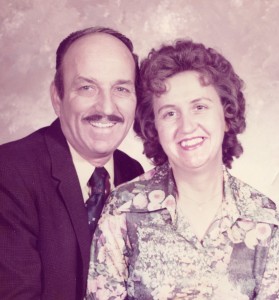
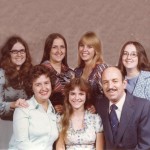
After our wonderful dinner and precious memories of our parents, now both in Heaven, the evening was over. I guess our time around the dinner table mush have bless more people than just us, because as we left, a lady approached my sister, Allyn and told her that they had really enjoyed our laughter. We ere pleased and left the restaurant with even lighter spirits. Today would have been our parents’ 70th anniversary. Happy anniversary Mom and Dad!! We love and miss you both so very much, and we can’t wait until we see you again.

 My daughter, Corrie Petersen and her husband, Kevin Petersen got married on July 17, 1993, meaning that this year is their 30th anniversary. Wow!! How can that be? I know it is, but it still seems like just yesterday that they said, “I do.” They say that the first years of a marriage can be the most difficult, but I never saw that in Corrie and Kevin’s marriage. For them the first years were blissful, and that bliss has only continued to grow as time has gone on.
My daughter, Corrie Petersen and her husband, Kevin Petersen got married on July 17, 1993, meaning that this year is their 30th anniversary. Wow!! How can that be? I know it is, but it still seems like just yesterday that they said, “I do.” They say that the first years of a marriage can be the most difficult, but I never saw that in Corrie and Kevin’s marriage. For them the first years were blissful, and that bliss has only continued to grow as time has gone on.
I can say that the last 6 years have maybe been the most eventful…and in some ways trying, but not in a negative way. These last six years have brought Corrie a new and exciting career in nursing, for which she has worked incredibly hard, and for which Kevin has sacrificed time with her so she could study. While Corrie’s studies and 
 career change have been hard work, they are now reaping the benefits of her success, and they are both very happy. Now they can start to spend more time together again, and they are loving that for sure, with plans to go camping soon.
career change have been hard work, they are now reaping the benefits of her success, and they are both very happy. Now they can start to spend more time together again, and they are loving that for sure, with plans to go camping soon.
The past 30 years have brought many life changes for this beautiful couple. Their family went from being a couple to a family of four, when their sons, Chris and Josh Petersen were born. Now their family has grown with the addition of two daughters-in-law, Karen and Athena Petersen, as well as grandchildren, Cambree, Caysen, and Justin Petersen. In addition, they are expecting two more grandsons in late September and mid-October. So not they are actually a family of eleven. Just look what love did.
The future is so bright for these two kids…I still get to call them kids, because they will always be my kids. It’s  a mother’s right. Even as adults with a growing family of their own and such a promising new career, they are my kids…both of them. I am the kind of person who never things of in-laws as in-laws. They are family and that makes this growing family my kids…all of them. The kids are so excited about the coming new babies, and they have been so blessed by their whole family. and they have all been a blessing to me and my husband, Bob Schulenberg, Corrie’s parents. Today is Corrie and Kevin’s 30th wedding anniversary. They say the 30th anniversary is the “pearl” anniversary. I say that these kids are “pearls” of great value!! Happy 30th anniversary Corrie and Kevin!! We are so proud of you both, and we love you very much.
a mother’s right. Even as adults with a growing family of their own and such a promising new career, they are my kids…both of them. I am the kind of person who never things of in-laws as in-laws. They are family and that makes this growing family my kids…all of them. The kids are so excited about the coming new babies, and they have been so blessed by their whole family. and they have all been a blessing to me and my husband, Bob Schulenberg, Corrie’s parents. Today is Corrie and Kevin’s 30th wedding anniversary. They say the 30th anniversary is the “pearl” anniversary. I say that these kids are “pearls” of great value!! Happy 30th anniversary Corrie and Kevin!! We are so proud of you both, and we love you very much.
 People have been fascinated with Saint Bernard dogs for years. There have been movies made about them, often portraying them as clumsy, drooling pests that “terrorize” homes by making massive messes. Saint Bernards might seem like they are big and clumsy, but for many years, they have been saving lives, and they weren’t clumsy about their work at all. In fact, they were experts at their work.
People have been fascinated with Saint Bernard dogs for years. There have been movies made about them, often portraying them as clumsy, drooling pests that “terrorize” homes by making massive messes. Saint Bernards might seem like they are big and clumsy, but for many years, they have been saving lives, and they weren’t clumsy about their work at all. In fact, they were experts at their work.
In the early 18th century some monks, who were living in the snowy and dangerous Saint Bernard Pass, which is a route through the Alps between Italy and Switzerland, kept these dogs to help them on their rescue missions after bad snowstorms. In fact, the Saint Bernard dogs got their name from the pass where the monks were located. Over a span of nearly 200 years, about 2,000 people, from lost children to Napoleon’s soldiers, were rescued because of the heroic dogs’ uncanny sense of direction and resistance to cold. Of course, there were changes in the dogs through crossbreeding, and finally the dogs became the amazing new breed they are today. While the dogs are amazing as rescue dogs, Saint Bernard dogs are also commonly seen in households today.
The dogs were trained to hunt for people who were lost, and when they found them, the dogs allegedly carried a small cask of liquor around their neck…although, this has not been documented for sure. Then, the dog would lay on top of the victim to keep them warm. Being lost in a snowstorm, often called “white death” could become a death sentence, because hypothermia would soon set in, and the victim would be lost. At a little more than 8,000 feet above sea level, the Great Saint Bernard Pass is a 49-mile route in the Western Alps. The pass is covered with snow for most of the year, and in fact, it is only snow free for a couple of months during the  summer. Throughout history, the route has been a treacherous one for many travelers. Of course, that didn’t stop people from trying to make the trek. An Augustine monk named Saint Bernard de Menthon founded a hospice and monastery around the year 1050, which is how Saint Bernard Pass came into being. Sometime between 1660 and 1670, the monks at Great Saint Bernard Hospice acquired their first Saint Bernards. These dogs were descendants of the mastiff style Asiatic dogs brought over by the Romans. The dogs were to be used as watchdogs and companions. The original Saint Bernards were quite a bit smaller in size, had shorter reddish brown and white fur, and a longer tail.
summer. Throughout history, the route has been a treacherous one for many travelers. Of course, that didn’t stop people from trying to make the trek. An Augustine monk named Saint Bernard de Menthon founded a hospice and monastery around the year 1050, which is how Saint Bernard Pass came into being. Sometime between 1660 and 1670, the monks at Great Saint Bernard Hospice acquired their first Saint Bernards. These dogs were descendants of the mastiff style Asiatic dogs brought over by the Romans. The dogs were to be used as watchdogs and companions. The original Saint Bernards were quite a bit smaller in size, had shorter reddish brown and white fur, and a longer tail.
Travel on the Saint Bernard Pass route was so dangerous, and at the turn of the century, servants used as guides were assigned to accompany travelers between the hospice and Bourg-Saint-Pierre, a municipality on the Swiss side. The trek was even treacherous for them, and by 1750, the guides were routinely accompanied by the dogs, whose broad chests helped to clear paths for travelers. While working with the dogs, the guides soon discovered that the dogs had a tremendous sense of smell, as well as their ability to discover people buried deep in the snow. Soon the dogs were sent out in packs of two or three alone to seek lost or injured travelers. Once they found a lost traveler, one dog would stay with the victim, while the other or others would go back to the hospice to bring help.
 So good were these dogs at their work, that when Napoleon and his 250,000 soldiers crossed through the pass between 1790 and 1810, not one soldier lost his life. The soldiers’ chronicles tell of how many lives were saved by the dogs in what the army had named “the White Death.” So amazing were these dogs, that one, named Barry, that was particularly legendary, who lived in the monastery from 1800-1812, saved the lives of more than 40 people. In 1815, Barry’s body was put on exhibit at the Natural History Museum in Berne, Switzerland, where it remains today. Saint Bernard dogs have proven themselves to be a vital part of mountain rescue operations.
So good were these dogs at their work, that when Napoleon and his 250,000 soldiers crossed through the pass between 1790 and 1810, not one soldier lost his life. The soldiers’ chronicles tell of how many lives were saved by the dogs in what the army had named “the White Death.” So amazing were these dogs, that one, named Barry, that was particularly legendary, who lived in the monastery from 1800-1812, saved the lives of more than 40 people. In 1815, Barry’s body was put on exhibit at the Natural History Museum in Berne, Switzerland, where it remains today. Saint Bernard dogs have proven themselves to be a vital part of mountain rescue operations.

